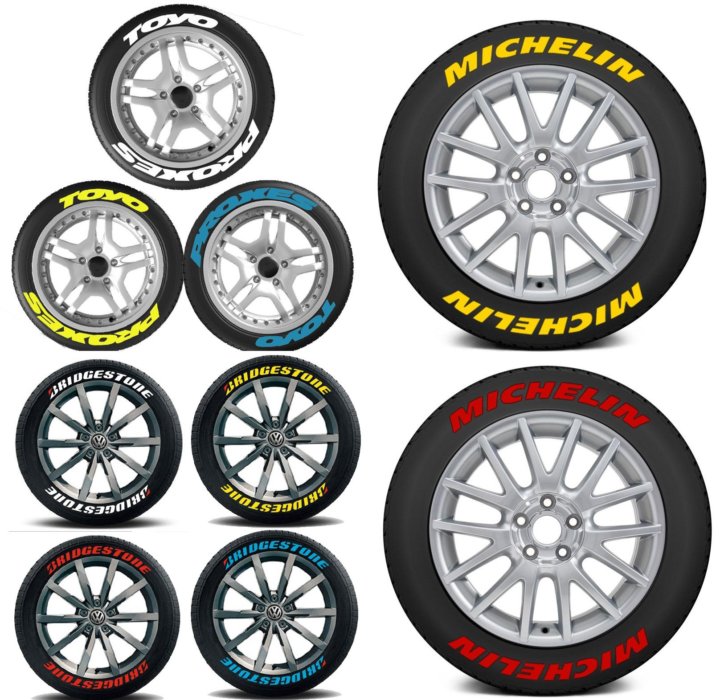One of the most fascinating winter tire facts is really all it’s cracked up to be! Toyo Tires has begun using Microbit Technology in its winter tires to improve winter traction. That’s ‘code word’ for walnut shells. That shell of a walnut is one of the hardest natural substances in the world, making it great for gripping icy roads. ‘Walnut’ Technology just doesn’t have the same ring…
These slices in your tread spread and close to grip the road surface as you drive over it. They also channel water out from under your tire when you’re driving on wet or snowy roads. Sipes were invented in a slaughterhouse in 1923 by a butcher who was tired of sliding around on bloody floors. He cut lines in the soles of his boots discovered that he then had a better grip. Even though it’s gross, those are true tire facts.
The rubber itself would mean you have white tires, not black. Manufacturers add carbon to the rubber in the manufacturing process which increases tensile strength ten-fold and causing the black color. But if your tires were white, what color would a burnout be? I’m so confused…
In the realm of fun tire facts, manufacturers have been working on puncture-resistant tires. In fact, they don’t hold air at all. Bridgestone and Michelin have both introduced airless tires that will never go flat. They’re bound to be expensive, so don’t go doing burnouts with them.
A set of Michelin tires can cost $42,000USD. It’s a set of four tires for a Bugatti Veyron Super Sport, and they’re capable of withstanding 258 miles per hour. And you thought your tires were pricey.
Between summer and winter, you could see 7PSI or more in tire pressure fluctuation because of water vapor suspended in the air in your tires. It reacts to temperature changes more than the surrounding air, causing the variations in cold and hot pressure. But if you fill your tires with nitrogen, there’s no fluctuation. Nitrogen doesn’t have any water vapor in it, so the pressure remains steady. I wonder how helium would work…
It reacts to temperature changes more than the surrounding air, causing the variations in cold and hot pressure. But if you fill your tires with nitrogen, there’s no fluctuation. Nitrogen doesn’t have any water vapor in it, so the pressure remains steady. I wonder how helium would work…
In miniature tire facts, no one holds a candle to the world’s highest producing tire manufacturer. The mini-toy maker, Lego, manufactures 308 million little Lego wheels every year, far exceeding any other tire manufacturer across the globe.
The world’s largest tire is 80 feet tall and over 12 tons. You can find it in Allen Park, Michigan. It was used as a Ferris wheel in the 1964 and ’65 World’s Fair, then moved there in 1966. Rumor has it the tire broke loose and rolled its way across I-94, but no one captured the moment on their smartphone. So, this isn’t actual tire facts, but a legend.
 It’s the worst tread life EVER!
It’s the worst tread life EVER!NHRA Top Fuel racing teams have to install new tires after every four to six passes down the track. On a quarter-mile track, that means those tires only last two or three miles! What’s the treadwear warranty again?
To lighten new cars for stricter emissions standards, many car manufacturers are opting not to include a spare tire with new vehicles. Instead, a tiny compressor and green ooze are provided, absolutely destroying the chance of reusing the tire.
By the way, I ‘lightened’ my car back in the eighties the same way. Or maybe I just forgot it on the roadside somewhere. we’ve compiled ten little-known tidbits to help kill some time.
You know that properly maintained tires are vital to the safe operation of your vehicle, but we bet you didn’t know the following 11 tire facts.
Early tires were white. Manufacturers added zinc oxide to the rubber for strength which had the side effect of turning them white.
Manufacturers added zinc oxide to the rubber for strength which had the side effect of turning them white.
In the early 1900s, tire color changed to black. In the early 1900s carbon black was added to the tires to increase tire durability and longevity.
White wall tires were first made in 1914. A whitewall tire is created when a carbon black tread is combined with a zinc white sidewall.
Original whitewalls were on both sides of the tire. Early cars had open fenders and pedestrians were able to see both sides of the tire when they drove by.
Run-flat tires can drive for a time without air. Run-flat tires will go around another 100 miles after losing tire pressure. They are designed to go around 50 miles when driving at 50mph, but if you drive at slower speeds you can get many more miles out of them. BMW uses the most run-flat tires.
Used tires produce a lot of waste. Every year there are more than 250 million used tires discarded. To help combat this problem, there are recycling programs that will melt the tire down to be used in asphalt. The tires may also be shredded and used in garden mulch. Sometimes new tires are made from the old. There are also crafty ways to recycle old tires like making them into planters, dog beds, swings, and other playground equipment.
To help combat this problem, there are recycling programs that will melt the tire down to be used in asphalt. The tires may also be shredded and used in garden mulch. Sometimes new tires are made from the old. There are also crafty ways to recycle old tires like making them into planters, dog beds, swings, and other playground equipment.
Most new cars don’t come with a spare tire. Many vehicle manufacturers, in an attempt to shed weight, stopped putting spare tires in new cars. Instead, they sell them with a patch kit and a can of compressed air.
Michelin is currently working on a new tire known as the “tweel.” It is described as an airless wheel and tire that comes in one piece. They hope to offer the reality of no flat tires and replaceable tread.
Lego is the leading tire manufacturer. They produce over 306 million mini tires a year.
The modern tire contains over 200 materials. The common materials in a tire include Kevlar, nylon, rubber, and steel, yet there is a lot more that goes into the manufacturing of a tire. They consist of metals like titanium and cobalt to help the compound bond to the steel belts. Silica and saline are also used to help enhance performance. Citrus oil and other “green” materials are also used.
They consist of metals like titanium and cobalt to help the compound bond to the steel belts. Silica and saline are also used to help enhance performance. Citrus oil and other “green” materials are also used.
You can find the World’s Largest Tire in Michigan. It is 80-feet-tall and weighs 12-ton and was originally used as a Ferris wheel at the 1964-65 New York’s World Fair. It was later moved to Allen Park in 1966.
We hope you found these facts about tires interesting! And remember, if you have any concerns with your vehicle you can call the automotive repair experts at Virginia Auto Service. Call 602.266.0200 or schedule an appointment online.
A little earlier, we already considered why it is important to change tires with the onset of the season. This time, let's look at some details about tires. Most likely, you know most of these facts, but it is still worth thinking about them. So, here are seven interesting facts.
In the 1950s and 1960s, it was considered exclusive to equip a car with white tires (or white inserts). It gave charm to the classic car.
The natural color of tires is actually white. Automakers add carbon particles to rubber. This is done out of the need to increase the working life of the product, as well as to improve the properties of tires.
Motorists who care about the safety (of themselves and their passengers) monitor the condition of tires and replace them with new ones in a timely manner. Because of this, a large number of unusable tires accumulate. Some in the private sector use them as front garden fencing.
Many countries have used tire recycling plants. Raw materials are not disposed of by incineration. In some cases, it is used to make asphalt. Others process tires into organic substances that are part of fertilizers. Some factories use this raw material to produce new rubber.
Strange as it may sound, Lego makes the most tires. For the manufacture of small parts of their designers, rubber is used. And the products are also called car tires.
For the manufacture of small parts of their designers, rubber is used. And the products are also called car tires.
Thanks to this, according to statistics, the largest supplier of tires is the company that produces children's toys. In one year, 306 million mini tires leave the production line.
The first inner tube tire appeared in 1846 by Scottish inventor Robert William Thomson. After Thomson's death (1873), his development was forgotten.
The idea was revived after 15 years. The inventor again turned out to be a Scot - John Boyd Dunlop. This is the name given to the discoverer of the pneumatic tire. The idea to equip the car with such a tire appeared when Dunlop put a rubber hose on the metal rim of his son's bicycle and inflated it with air.
In 1839, Charles Goodyear discovered the process of hardening rubber. For 9 years, the American inventor tried to stabilize the process by conducting various experiments, but he did not achieve the ideal effect. One of the experiments was the process of mixing rubber and sulfur on a hot plate. As a result of a chemical reaction, a solid lump was formed at the contact point.
One of the experiments was the process of mixing rubber and sulfur on a hot plate. As a result of a chemical reaction, a solid lump was formed at the contact point.
The Davis brothers (Tom and Voltaire) came up with the idea to equip the car with a spare wheel. Under 19For 04 years, no automaker has completed its products with an additional wheel. The innovators were inspired by the opportunity to complete all the cars that went into the series.
The idea was so relevant that they distributed their products not only to the American but also to the European market. The first car with a factory-equipped spare was the Rambler. The idea was so popular that some cars had two spares.
Today, in an effort to lighten cars, manufacturers have removed the standard spare wheel (5th wheel, identical in size to the kit) from their models. In most cases, it was replaced by a dokatka (a thin wheel of the appropriate diameter). It will take you to the nearest tire shop.
It will take you to the nearest tire shop.
Some automakers have gone even further - they have completely eliminated the possibility of using even a stowaway. Instead of a spare tire, the car comes with a quick cure kit. Such a kit can be purchased by yourself (popularly it is called "laces") at a reasonable price.
2019-01-10
The history of the invention of many familiar objects is a combination of happy accidents and hard work. When purchasing another set of tires for a passenger car or tires for special equipment, hardly anyone wonders how it all began. Here are some interesting facts about the creation and use of automotive rubber.
By chance. In the 1830s, American inventor Charles Goodyear was desperately looking for a way to turn soft but fragile rubber into durable rubber. He conducted a series of experiments and spent his own savings on them, but there was still no positive result.
Once Goodyear threw another sample of rubber mixed with sulfur into a red-hot furnace, and forgot about it. Later, while cleaning the equipment, he found an elastic lump inside with good stretch and density. The patent was filed in 1844, but the inventor did not seek commercial gain and ended up in debt. But the well-known tire company Goodyear was named in his honor.
In 1846, the Scotsman Robert William Thomson received a patent for his proposal to reinforce the elastic surfaces of the wheels on carriages in order to reduce noise from urban traffic. It took another forty-two years before his compatriot - John Dunlop - began to actively use vulcanized rubber as bicycle tires on children's and sports models. Dunlop started history with this innovation. But the idea to install durable rubber on cars belonged to the French industrialists - the Michelin brothers, who then founded the production concern of the same name.
Yes, it will even be possible to reach speeds of up to 55 km / h. These were the results of tests conducted in 1959 by the American Albert Sfredd. The bizarre car did an excellent job of moving on a snowy and sandy road, the secret was in a special way of attaching the wheels to the axles (at an angle). The engineer counted on the support of army designers, but the matter did not move beyond a couple of test samples.
These were the results of tests conducted in 1959 by the American Albert Sfredd. The bizarre car did an excellent job of moving on a snowy and sandy road, the secret was in a special way of attaching the wheels to the axles (at an angle). The engineer counted on the support of army designers, but the matter did not move beyond a couple of test samples.
The largest car tires are 4 meters wide and weigh 5 tons - such models are installed on large dump trucks, for example, BelAZ. For comparison: a pneumatic tire 12-16.5 inches for special equipment is 200 times lighter.
But the smallest wheels with rubber were made for a miniature collectible Toyota. Their diameter is only 4.8 mm, and the width is 0.8 mm.
And finally - about the unusual use that waste tires receive in Colombia. There is a workshop here, where clothes and shoes are made from tires found in a landfill. Craftsmen use mainly winter tires, because. it lends itself well to deformation.